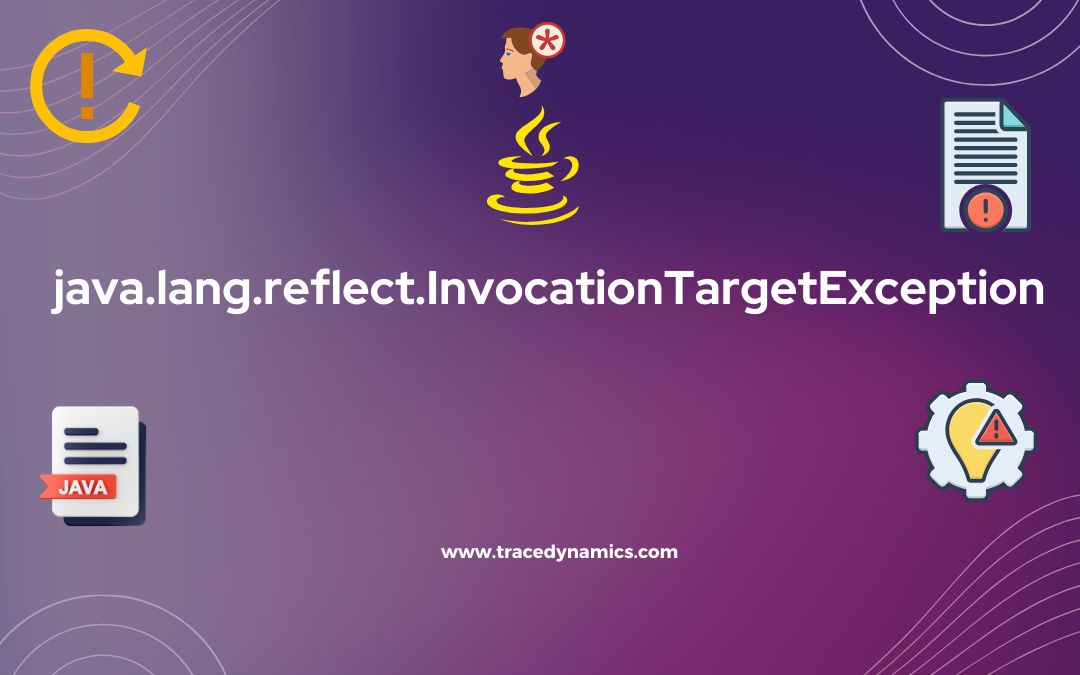java.lang.reflect.InvocationTargetException is a checked exception that encapsulates an exception thrown by an invoked method or constructor in Java. Delving into this exception, understanding its causes, and discerning how to handle it proficiently can significantly ameliorate the debugging process for Java developers.
Key Takeaways:
- Understanding: Grasping the essence of
java.lang.reflect.InvocationTargetException. - Causes: Delving into common scenarios that trigger this exception.
- Handling: Strategies to unravel and handle this exception proficiently.
- Solutions: Practical solutions and workarounds to mitigate or resolve the issues leading to this exception.
- Community Insights: Leveraging communal knowledge and experiences to better cope with this exception.
Causes of java.lang.reflect.InvocationTargetException
Common Triggers
java.lang.reflect.InvocationTargetException is typically thrown when the Method.invoke() or Constructor.newInstance() of the reflection classes in Java is utilized, and the method or constructor being invoked throws an exception.
Table: Common Scenarios Leading to InvocationTargetException
| Scenario | Description |
|---|---|
| Improper Method Call | Invoking a method with incorrect parameters or at an improper time. |
| Runtime Exceptions | Exceptions thrown during the execution of the invoked method or constructor. |
| Error Conditions | Any error conditions encountered during the reflection operation. |
Reflection and Exception Wrapping
In Java, reflection is a powerful feature that allows for programmatic access to the information about Java classes and objects, including method invocation at runtime. However, when an invoked method throws an exception, it gets wrapped in a java.lang.reflect.InvocationTargetException, which adds an additional layer of abstraction to the original exception.
Handling java.lang.reflect.InvocationTargetException
Unwrapping the Exception
One of the primary steps in dealing with java.lang.reflect.InvocationTargetException is to unwrap the exception to discern the real cause of the problem. This entails obtaining the original exception, which can be achieved using the getTargetException() method on the InvocationTargetException instance.
Table: Steps to Unwrap InvocationTargetException
| Step | Action |
|---|---|
| 1 | Catch InvocationTargetException |
| 2 | Call getTargetException() method |
| 3 | Analyze the original exception for cause and resolution |
Logging and Debugging Techniques
Effective logging and debugging are indispensable in identifying and rectifying the issues leading to java.lang.reflect.InvocationTargetException. Employing robust logging frameworks and debugging tools can significantly expedite the troubleshooting process.
- Logging: Utilize logging frameworks like Log4j or SLF4J to log exceptions, including the stack trace, which can provide invaluable insights into the error conditions.
- Debugging: Leverage debugging tools integrated within IDEs to step through the code, inspect variables, and understand the flow leading to the exception.
Solutions and Workarounds
Configuring Java Console
Ensuring that the Java Console is correctly configured to display or log exceptions is crucial for diagnosing and resolving
java.lang.reflect.InvocationTargetException. The console can provide real-time feedback and error logging, aiding in identifying the root cause of the exception.Table: Configuring Java Console for Exception Handling
| Action | Description |
|---|---|
| Enable Console | Ensure that the Java Console is enabled for displaying exceptions |
| Set Logging Level | Adjust the logging level to capture the necessary details of exceptions |
| Review Logs | Analyze the logs to identify the root cause and potential solutions |
Common Solutions
Here are some common solutions to mitigate or resolve the issues leading to java.lang.reflect.InvocationTargetException:
- Code Review: Conduct a thorough review of the code to identify and rectify any erroneous method calls or improper use of reflection.
- Exception Handling: Enhance exception handling mechanisms to catch and deal with exceptions proficiently.
- Testing: Employ rigorous testing methodologies to identify and fix potential issues before they escalate into production environments.
Community Insights
Tackling java.lang.reflect.InvocationTargetException proficiently often requires a blend of individual knowledge and communal insights. The Java community, being vast and diverse, has an array of experiences and solutions that could be highly beneficial.
Experiences from Seasoned Developers
Leveraging the experiences of seasoned developers who have tackled java.lang.reflect.InvocationTargetException can provide invaluable insights. Their strategies, solutions, and workarounds could serve as a cornerstone for understanding and resolving this exception.
Online Forums and Discussions
Engaging in online forums and discussions can lead to discovering novel solutions and gaining a deeper understanding of java.lang.reflect.InvocationTargetException
.Practical Strategies
Implementing practical strategies can significantly ameliorate the handling of java.lang.reflect.InvocationTargetException. Here are some actionable steps:
- Error Logging: Ensure robust error logging is in place to capture all necessary information when the exception occurs.
- Code Analysis: Utilize static code analysis tools to identify potential issues that could lead to this exception.
- Community Engagement: Engage with the Java community to share experiences and solutions regarding java.lang.reflect.InvocationTargetException.
Wrapping Up
Through a comprehensive exploration of java.lang.reflect.InvocationTargetException, we have unearthed its causes, strategies for handling it, and practical solutions to mitigate or resolve the issues leading to this exception. The key to proficiently dealing with this exception lies in a blend of solid understanding, practical strategies, and leveraging communal insights. The resources, discussions, and experiences shared within the Java community are invaluable assets in navigating the challenges posed by java.lang.reflect.InvocationTargetException
.Frequently Asked Questions (FAQs)
What is java.lang.reflect.InvocationTargetException?
java.lang.reflect.InvocationTargetException is a checked exception that arises when an invoked method or constructor throws an exception. This exception acts as a wrapper for the actual exception thrown.
How can I resolve java.lang.reflect.InvocationTargetException?
To resolve this exception, you need to: – Catch the InvocationTargetException. – Unwrap the actual exception using the getTargetException() method. – Investigate and fix the underlying cause of the actual exception.
Why is java.lang.reflect.InvocationTargetException a checked exception?
This exception is checked to ensure that developers handle or declare it, promoting better error management and robustness in Java applications.
Can java.lang.reflect.InvocationTargetException be prevented?
While it might not always be preventable, employing good programming practices, thorough testing, and robust exception handling can significantly minimize occurrences.
Where can I find more resources on handling java.lang.reflect.InvocationTargetException?
Numerous online communities, forums, and documentation, like StackOverflow, provide a wealth of information and solutions related to this exception.

